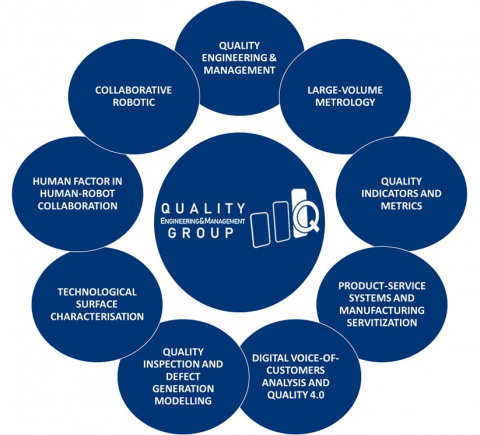Research
The Quality Engineering and Management Group carries out research activities in the fields of Quality Management, Industrial Metrology and Statistical Quality Control and Collaborative Robotics.

In detail, the main research topics are:
QUALITY ENGINEERING & MANAGEMENT
The subject of Quality Engineering and Management is very broad. At the risk of oversimplification, it concerns the improvement of the design of products or services, to make them more reliable and in line with customer expectations. Furthermore, it is about reducing product and process variability, quality costs and maximising customer satisfaction through improved product performance.
The group' s research in this area is also extremely multifaceted, ranging from the development of innovative techniques for product/service design (e.g., QFD and FMECA context) to process capability analysis of innovative manufacturing systems (e.g., distributed additive manufacturing centers), to the development of advanced techniques for benchmarking between alternative design solutions.
- Mastrogiacomo, L., Carrozza, A., Maisano, D., Franceschini, F. (2021) Is ‘post-decline’ the next phase of the diffusion of ISO 9001 certifications? New empirical evidence from European countries, TOTAL QUALITY MANAGEMENT & BUSINESS EXCELLENCE, 32(11-12):1384-1403
- Franceschini F., Maisano D., Mastrogiacomo L. (2016) A new proposal for fusing individual preference orderings by rank-ordered agents: A generalization of the Yager’s algorithm, EUROPEAN JOURNAL OF OPERATIONAL RESEARCH, 249(1):209-223
- Franceschini F., Maisano D. (2015) Checking the consistency of the solution in ordinal semi-democratic decision making problems, OMEGA, 57(1):188-195
LARGE-VOLUME METROLOGY
The inspection of very large objects requires dedicated metrology solutions and technologies. Over the past decades, Large-Volume Metrology has developed innovative technologies – i.e., laser-trackers, rotary laser automated theodolites, laser scanners, photogrammetric systems, etc. – that can be used in a wide range of measurement and inspection applications (e.g., analysing the fuselage section of aircrafts, building the hull of cruise ships, inspecting the assembly and alignment of tools, checking the geometry of aircraft wings, etc.). The research group is active in the development of innovative prototype measuring instruments and new measuring techniques. It also carries out important projects with industrial partners.
- Maisano, D.A., Mastrogiacomo, L. (2022). Determining the extrinsic parameters of a network of Large-Volume Metrology sensors of different types. , PRECISION ENGINEERING, 74, 316-333.
- Maisano, Domenico; Mastrogiacomo, Luca (2018) A novel multi-target modular probe for multiple Large-Volume Metrology systems, PRECISION ENGINEERING, 52:30-54,
- Galetto M., Mastrogiacomo L., Maisano D., Franceschini F. (2016) Uncertainty evaluation of distributed Large-Scale-Metrology systems by a Monte Carlo approach, CIRP ANNALS, 65(1):491-494
QUALITY INDICATORS AND METRICS
Indicators are a vehicle for conveying information, behavioural codes, governance rules and accompany the daily life of public and private organisations in many fields: from the stock exchange to meteorology, from production processes to sporting specialities. Indicators regulate and influence organisations and their behaviour. The need to establish long-term objectives, rules and behaviour in order to achieve expected results puts indicators at the centre of attention of organisations' stakeholders. The research group has always been engaged in the development, conceptual and critical analysis of performance indicators in various fields, such as quality engineering, production control, economics/finance, scientometrics, etc.
- Franceschini, F., Maisano, D. (2020) Decision concordance with incomplete expert rankings in manufacturing applications, RESEARCH IN ENGINEERING DESIGN, 31(4):471-490,
- Franceschini, F., Maisano, D. (2020) Adapting Thurstone’s Law of Comparative Judgment to fuse preference orderings in manufacturing applications, JOURNAL OF INTELLIGENT MANUFACTURING, 31(2):387-402
- Franceschini F., Maisano D., Mastrogiacomo L. (2016) Empirical analysis and classification of database errors in Scopus and Web of Science, JOURNAL OF INFORMETRICS, 10(4):933-953,
PRODUCT-SERVICE SYSTEMS AND MANUFACTURING SERVITIZATION
The introduction of advanced technologies and new production paradigms has led an increasing number of manufacturing companies to adopt business models that include an integrated provision of products and services, the so-called Product-Service Systems. This process is generally referred to as servitization. The group' s research in this area deals with the development of practical tools and approaches to support manufacturing companies in the servitization process, to design Product-Service Systems and manage their quality.
- Barravecchia, F.; Franceschini, F.; Mastrogiacomo, L.; Zaki, M. (2021) Research on product-service systems: topic landscape and future trends, JOURNAL OF MANUFACTURING TECHNOLOGY MANAGEMENT, 32, 208-238
- Mastrogiacomo, L.; Barravecchia, F.; Franceschini, F.. (2020) Enabling factors of manufacturing servitization: Empirical analysis and implications for strategic positioning, PROCEEDINGS OF THE INSTITUTION OF MECHANICAL ENGINEERS. PART B, JOURNAL OF ENGINEERING MANUFACTURE, 234, 1258-1270
- Mastrogiacomo, L.; Barravecchia, F.; Franceschini, F.. (2019) A worldwide survey on manufacturing servitization, INTERNATIONAL JOURNAL, ADVANCED MANUFACTURING TECHNOLOGY, 103, 3927-3942
DIGITAL VOICE-OF-CUSTOMERS ANALYSIS AND QUALITY 4.0
Digital Voice-of-Customer (digital VoC) analysis is gaining much attention in the field of quality management. Digital VoC can be a great source of knowledge about customer needs, habits, and expectations.Manufacturers and service providers need new tools to leverage the value of the digital Voice-of-Customer (VoC). These unstructured and disorganised data need ad-hoc approaches for their analysis and interpretation. The research group is active in the development of methodologies for the analysis of Digital Voice-of-Customer to support quality design and management.
- Barravecchia, F.; Mastrogiacomo, L. ; Franceschini, F. KA-VoC Map: Classifying product Key-Attributes from digital Voice-of-Customer, QUALITY ENGINEERING, 34, 344-358
- Mastrogiacomo, L., Barravecchia, F., Franceschini, F., & Marimon, F. (2021). Mining quality determinants of product-service systems from user-generated contents. QUALITY ENGINEERING, 33(3), 425-442.
- Barravecchia, F., Mastrogiacomo, L., & Franceschini, F. (2021). Digital voice-of-customer processing by topic modelling algorithms: insights to validate empirical results. INTERNATIONAL JOURNAL OF QUALITY & RELIABILITY MANAGEMENT. 39(6), 1453-1470
QUALITY INSPECTION AND DEFECT GENERATION MODELLING
Study, implementation, and planning of quality inspection procedures in manufacturing processes. Study of product complexity and modelling of defect generation in manual and human-robot collaborative assembly and disassembly processes.
- Verna E., Genta G., Galetto M., Franceschini F. (2020) Planning offline inspection strategies in low-volume manufacturing processes. QUALITY ENGINEERING, 32(4), 705–720
- Galetto M, Verna E, Genta G (2021) Effect of process parameters on parts quality and process efficiency of Fused Deposition Modeling. COMPUTERS & INDUSTRIAL ENGINEERING
- Verna E, Genta G, Galetto M, Franceschini F (2022) Defects-per-unit control chart for assembled products based on defect prediction models. THE INTERNATIONAL JOURNAL OF ADVANCED MANUFACTURING TECHNOLOGY, 119, 2835–2846
TECHNOLOGICAL SURFACE CHARACTERISATION
Surface topography characterization for tribological applications and for additively manufactured surfaces. Non-conventional hardness testing for surface mechanical characterization.
- Maculotti G., Genta G., Quagliotti D., Galetto M., Hansen H..N. (2021) Gaussian process regression-based detection and correction of disturbances in surface topography measurements QUALITY AND RELIABILITY ENGINEERING INTERNATIONAL 38, 1501-1518
- Maculotti, G., Goti, E., Genta, G., Mazza, L., & Galetto, M. (2022). Uncertainty-based comparison of conventional and surface topography-based methods for wear volume evaluation in pin-on-disc tribological test. TRIBOLOGY INTERNATIONAL, 165, 107260.
- G. Genta, G. Maculotti, G, “Uncertainty evaluation of small wear measurements on complex technological surfaces by machine vision-aided topographical methods”, CIRP ANNALS – MANUFACTURING TECHNOLOGY, (2021) 70(1): 451-454
HUMAN FACTOR IN HUMAN-ROBOT COLLABORATION
Human-Robot Collaboration (HRC) is a form of direct interaction between humans and robots. The objective of this type of interaction is to perform a task by combining the skills of both humans and robots. HRC is characterized by several aspects, related both to robots and humans. The research groups carry out study and research activities on the human factor involved in Human-Robot Collaboration in manufacturing in order to achieve a more symbiotic collaboration between operators and robots.
- Gervasi, R., Barravecchia, F., Mastrogiacomo, L., & Franceschini, F. (2022). Applications of affective computing in human-robot interaction: State-of-art and challenges for manufacturing. PROCEEDINGS OF THE INSTITUTION OF MECHANICAL ENGINEERS, PART B: JOURNAL OF ENGINEERING MANUFACTURE
- Gervasi, R., Mastrogiacomo, L., & Franceschini, F. (2020). A conceptual framework to evaluate human-robot collaboration. THE INTERNATIONAL JOURNAL OF ADVANCED MANUFACTURING TECHNOLOGY, 108(3), 841-865.
- Gervasi, R., Mastrogiacomo, L., Maisano, D. A., Antonelli, D., & Franceschini, F. (2022). A structured methodology to support human–robot collaboration configuration choice. PRODUCTION ENGINEERING, 16(4), 435-451.
COLLABORATIVE ROBOTIC
With "collaborative robotics" we refer to those a new generation of robotic systems that physically interact safely with humans and share their space. A disruptive innovation that opens the way to a different way of using robotics in the industrial sector. In the human-robot interaction the aspects of the perception of the environment and the prediction of human intention represent a fundamental requirement that the collaborative robots (cobots) must satisfy to coexist and collaborate safely with the man. The research of the team employs industrial state of the art cobots and explore the dimensions of cognitive, emotional and ergonomic stress on the human worker.
- Aliev, K., & Antonelli, D. (2021). Proposal of a monitoring system for collaborative robots to predict outages and to assess reliability factors exploiting machine learning. APPLIED SCIENCES, 11(4), 1621.
- Stadnicka, D., & Antonelli, D. (2019). Human-robot collaborative work cell implementation through lean thinking. INTERNATIONAL JOURNAL OF COMPUTER INTEGRATED MANUFACTURING, 32(6), 580-595.
- Bruno, G., & Antonelli, D. (2018). Dynamic task classification and assignment for the management of human-robot collaborative teams in workcells. THE INTERNATIONAL JOURNAL OF ADVANCED MANUFACTURING TECHNOLOGY, 98(9), 2415-2427.

